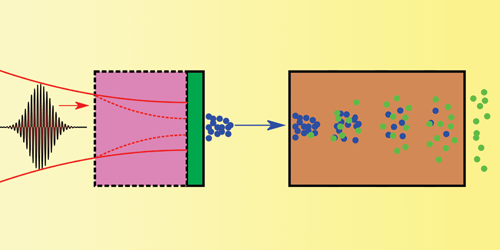How Lasers Could Build Heavy Elements
Elements heavier than iron are thought to be born in neutron-star mergers. In these events, nuclei can capture additional neutrons then decay via beta emission into isotopes with higher atomic numbers. Since the 1950s, experimentalists have sought to decipher the stellar conditions under which sequences of these neutron captures occur. But a description has been elusive because of the difficulty of generating the extreme neutron fluxes required to create neutron-rich isotopes in the lab. Vojtěch Horný of the Laboratory for the Use of Intense Lasers in France and his colleagues now identify specific parameter limitations that stand between present-day lasers and future laser-driven reactors that could yield neutron fluxes suitable for nucleosynthesis demonstrations [1]. Their calculations show what it would take to offer realistic prospects for laser-based generation of neutron-rich isotopes.
Generating neutrons using lasers typically involves two stages: first, a laser pulse ionizes hydrogen atoms in a thin foil and accelerates them to MeV energies; then, these hydrogen nuclei trigger neutron-generating nuclear reactions in a high-atomic-number material. Using numerical simulations, Horný and his team calculated how many neutron-rich isotopes could be created by having the resulting neutron beam strike a gold target. They found that currently available lasers would produce only negligible numbers of neutron-rich isotopes, defined as those with at least two more neutrons than the seed nucleus. Further calculations indicated that a desirable isotope count could be achieved by slowing the neutrons to very low energies (to boost their capture cross sections) and by pulsing the laser at a sustained 100 Hz. While the necessary neutron energies can be achieved using present-day techniques, the laser pulse rates required for this scheme will only be possible using next-generation devices.
–Rachel Berkowitz
Rachel Berkowitz is a Corresponding Editor for Physics Magazine based in Vancouver, Canada.
References
- V. Horný et al., “Quantitative feasibility study of sequential neutron captures using intense lasers,” Phys. Rev. C 109, 025802 (2024).




